The Railway Through the Central Highlands by David Price combines a travelogue with an appreciation of the spectacular railway line from Perth to Inverness.
Published in March this year and written by David Price, this softcover book comes in the usual Amberley format of around 234 mm x 165 mm with 96 pages, 180 colour photographs and a route map.
It has a published price of £15.99 but at the time of writing it can be obtained online from Amberley Publishing at £14.39 and from Amazon for £15.25.
With a selection of steam and diesel photographs showing the different traction in use during this period, there is no shortage of trains forming part of the landscape rather than concentrating on the trains themselves. As the book progresses, so does the scenery become ever more desolate and mountainous, without losing sight that this is primarily a book about trains.
Using the map in the Introduction as a guide, the reader can enjoy a journey on one of the UK’s most scenic railway journeys. The captions, though short, provide sufficient detail to track the locations along the way. There is a balanced mix of diesel and steam locomotives on regular services and rail tours, and of passenger and freight trains in many different locations along the line.
Also included are sections on the now-closed Cairngorm Mountain Railway and the restored Strathspey Railway from Aviemore. Highly recommended, not only for those with an interest in Scottish railways, but for anyone who loves the Highlands of Scotland.
A surprising omission was the absence of photographs of Class 26/D53xx diesel locomotives, which for many years were the mainstay of Perth to Inverness services.
Below is a hark back to earlier times with, at the top left, preserved former North British 0-6-0 Maude approaching Perth, balanced by Class 47 Holyrood and its rake of coaching stock in ScotRail’s Saltire livery on the opposite page. The bottom photographs on each page bring back memories of steam’s swansong with LNER A4 Class Pacifics on three-hour Glasgow to Aberdeen expresses.
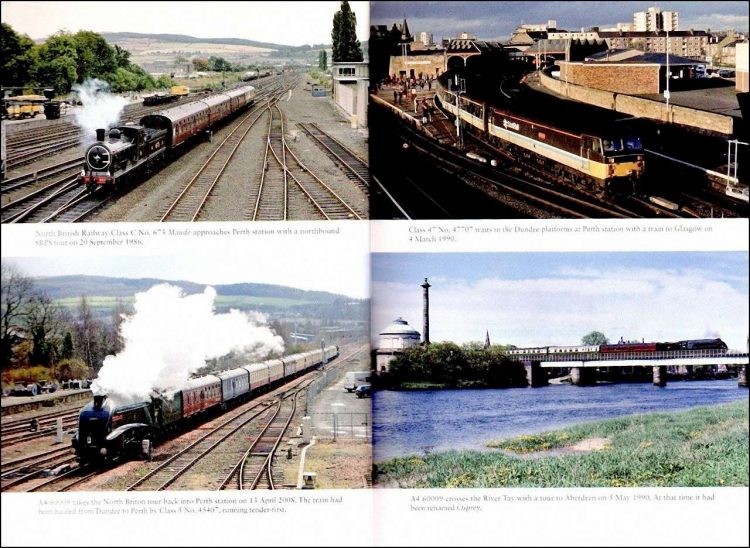
We get a taste of the mountainous terrain that lies further north with these pages capturing trains among low hills. On the right are two views of the site of Ballinluig station, which was originally the junction for a branch train to Aberfeldy. For some reason, the author has chosen to spell it as Ballanluig, possibly as a throwback to its Gaelic spelling of Baile an Luig.
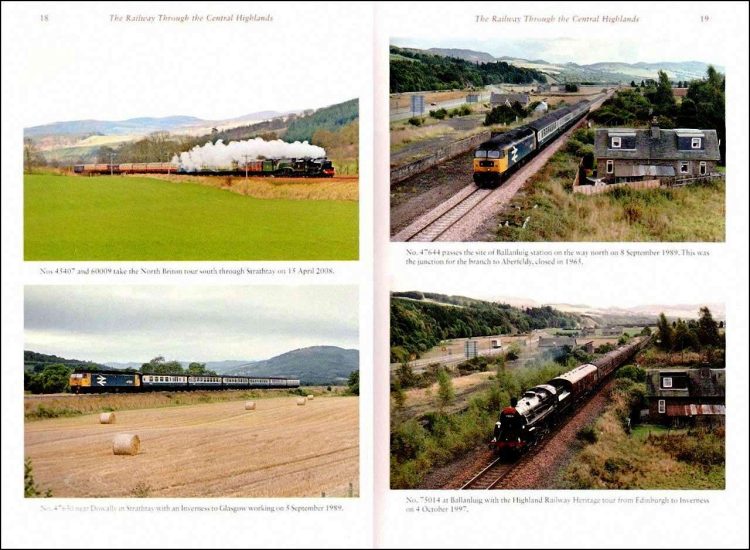
For anyone travelling on the Highland line, one of the memorable sights on the journey north is travelling alongside the River Garry through the Pass of Killiecrankie. The author has captured the location perfectly at the bottom right, with an Inverness-bound train juxtaposed between the A9 road at the top and a fly fisherman in the River Garry at the bottom. The LMS Class 5 4-6-0s on the left will bring back memories for anyone who travelled the line in steam days.
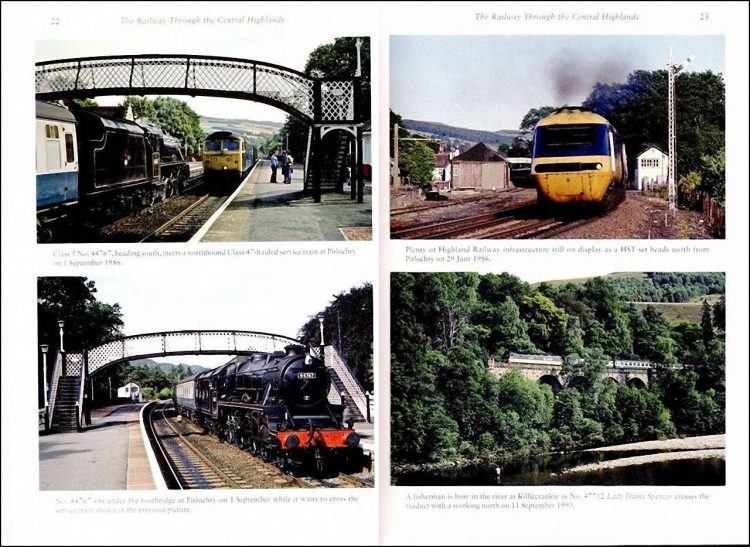
Further memories of steam days are stirred by the sight of LMS Class 5 4-6-0s working hard up to Druimochter summit, the highest point on any standard gauge railway line in the United Kingdom. But looking out of place are the Class 8F at the top left and the LNER Class A4 coupled behind the Class 5 at the lower right.
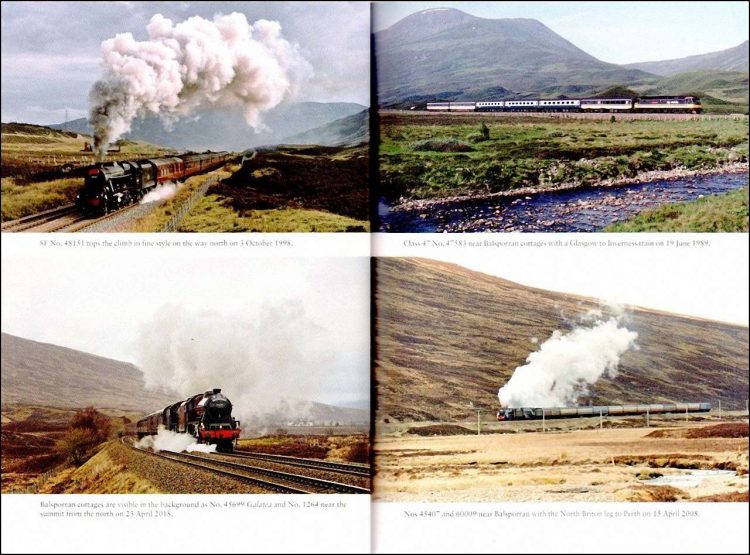
Even though the book contains many examples of special trains, the day-to-day workhorse in recent years has been Class 158 diesel multiple units. Perhaps it is a case of over-familiarity why the unit shown below is the book’s only example.
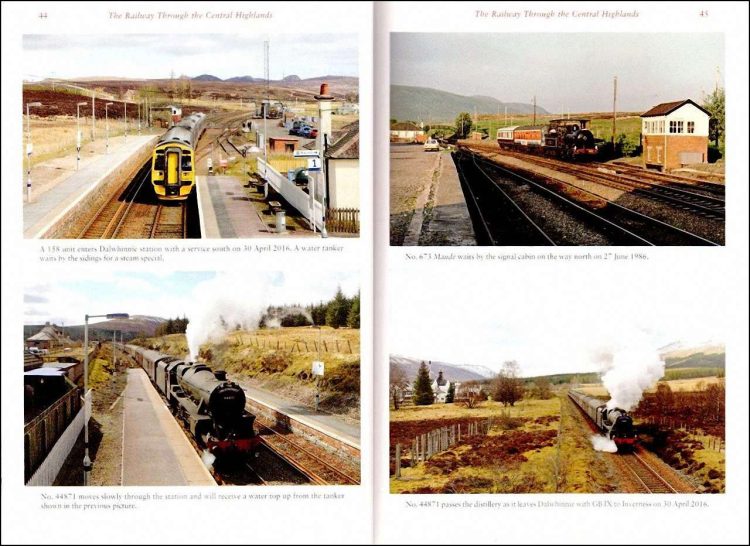
In summary, this book provides a balanced mix of diesel and steam locomotives on regular services and rail tours, and of passenger and freight trains in many different locations along one of the UK’s most-scenic lines. Also included are sections on the now-closed Cairngorm Mountain Railway and the restored Strathspey Railway from Aviemore. A minor criticism is the absence of Class 26/D53xx diesel locomotives and just a solitary Class 158 diesel multiple unit, both of which for many years were the mainstay of Perth to Inverness services. However, this book is highly recommended for anyone with an interest in the railways of the Highlands of Scotland.
The book is available to purchase from Amazon as well as from Amberley Publishing.
We would like to thank Amberley Publishing for providing RailAdvent with a copy of the book for review.






Responses
The “now-closed Cairngorm Mountain Railway” has been repaired and is about to re-open